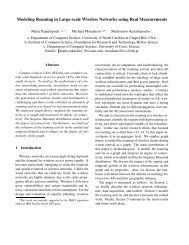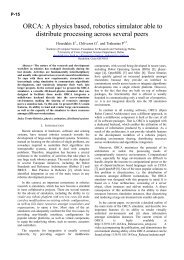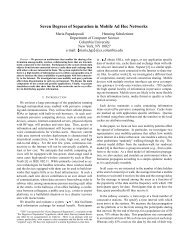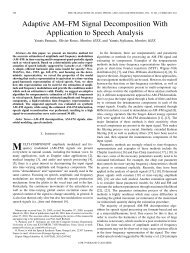Master Thesis - ICS
Master Thesis - ICS
Master Thesis - ICS
Create successful ePaper yourself
Turn your PDF publications into a flip-book with our unique Google optimized e-Paper software.
Computer Science Department<br />
Antonis Misargopoulos<br />
may eventually extend to applications and physical devices. Enterprise distributed<br />
computing technologies such as CORBA and Enterprise Java enable resource sharing<br />
within a single organization. The open group’s Distributed Computing Environment –<br />
DCE supports secure resource sharing across sites, but most VOs would find it too<br />
burdensome and inflexible.<br />
It is here that Grid technologies enter the picture. Over the past five years,<br />
research and development efforts within the Grid community have produced protocols,<br />
services, and tools that address precisely the challenges that arise building scalable VOs.<br />
These technologies include security solutions that support management of credentials and<br />
policies when computations span multiple institutions; resource management protocols<br />
and services that support secure remote access to computing and data resources, and the<br />
co-allocation of multiple resources; information query protocols and services that provide<br />
configuration and status information about resources, organizations, and services; and<br />
data management services that locate and transport datasets between storage systems and<br />
applications. However, because of their focus on dynamic cross-organizational sharing,<br />
Grid technologies complement rather than compete with existing distributed computing<br />
technologies. For instance, enterprise distributed computing systems can use Grid<br />
technologies to achieve resource sharing across institutional boundaries or establish<br />
dynamic markets for computing and storage resources.<br />
2.3 The Evolution of the Grid<br />
In this section, we are going to present an overview of Grids evolution over the last years.<br />
We distinguish three generations, according to the technology and the contributions they<br />
introduced [4]. In particular, first generation systems which were the forerunners of the<br />
Grid as we recognize it today; second generation systems with a focus on middleware to<br />
support large scale data and computation; and third generation systems where the<br />
emphasis shifts to distributed global collaboration, a service oriented approach and<br />
information layer issues.<br />
8

















